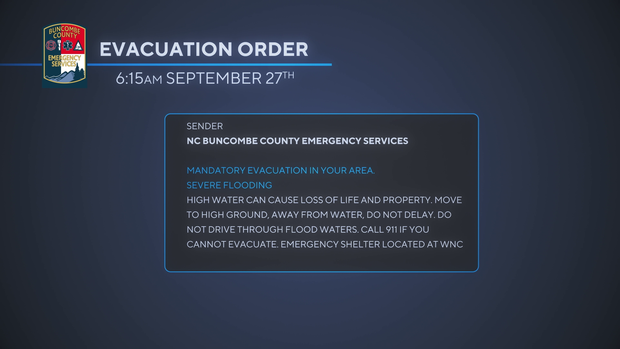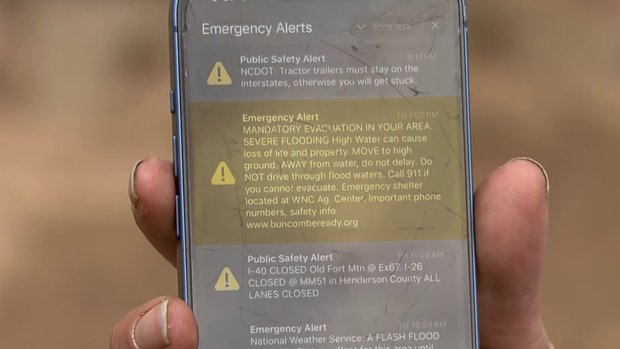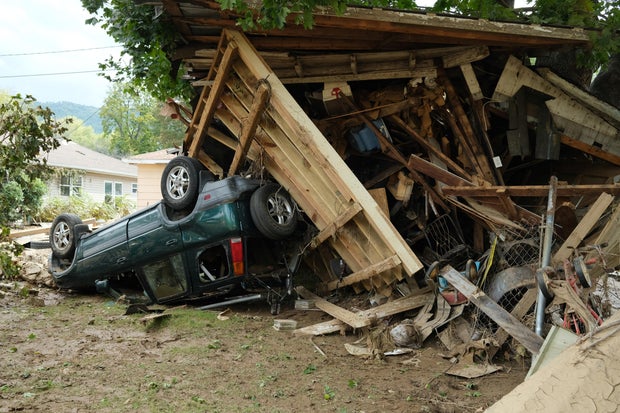CBS News
Mark Harmon on returning to NCIS world as producer of prequel “NCIS: Origins”

Watch CBS News
Be the first to know
Get browser notifications for breaking news, live events, and exclusive reporting.
CBS News
Black plastic items could contain harmful chemicals, study finds

Watch CBS News
Be the first to know
Get browser notifications for breaking news, live events, and exclusive reporting.
CBS News
Recovery efforts underway in aftermath of Hurricane Milton

Watch CBS News
Be the first to know
Get browser notifications for breaking news, live events, and exclusive reporting.
CBS News
Why some people in Hurricane Helene’s path didn’t get emergency alerts

Zoe Dadian’s front yard became a front line when the remnants of Hurricane Helene caused catastrophic flooding in her community of Swannanoa, North Carolina.
“It’s just like a horror show, just standing there on solid ground while full houses floated by with people sitting on top, like screaming for their lives,” Dadian said.
When the floodwaters receded, neighbors started talking about the warnings that came before.
Severe weather watches and warnings are sent by the National Weather Service, but evacuation orders come from local authorities.
Many use the Federal Emergency Management Agency’s Integrated Public Alert and Warning System — or IPAWS — which pushes messages to cellphones, TVs and radios in disaster-impacted areas.
Buncombe County, where Dadian lives, sent a mandatory evacuation order out through IPAWS at 6:15 a.m. on Sept. 27.
CBS
She said the alert didn’t show up on her phone until hours later — at 1 p.m.
CBS
“And at that point, the landslide had occurred,” Dadian said. “We were digging bodies out of rubble, and there was nowhere to evacuate.”
Buncombe County officials said many cell towers were down because of the flooding, which may have delayed the transmission of the evacuation order.
“The cell towers are a critical piece,” FEMA Administrator Deanne Criswell said about the challenge of timely alerts during flash floods.
“We need to keep learning on how we can better warn people even if we don’t know exactly where the flash flooding’s going to happen,” Criswell said.
Ulysse Bellier/AFP via Getty Images
While downed cell towers may have stopped or delayed alerts from reaching everyone, some counties certified to issue IPAWS alerts did not send any, according to a CBS News analysis of available FEMA data. Of 43 counties that experienced deaths during Helene, 29 did not send out alerts using IPAWS.
Brian Toolan, Connecticut’s former emergency operations chief who now builds local alert software, said a county, especially small counties, can get overwhelmed quickly.
“The timelines are going to be critical to understand was there enough time to get an alert out, you know, was there enough time to prepare, you know, and if not, you know, how do we learn from this and make sure this doesn’t happen again?” he said.
CBS News also reviewed FEMA data during Hurricane Milton. At least 46 alerts were sent this week by 14 counties across Florida, including those along the west coast where the storm made landfall and conditions were the most dangerous. At least 25 alerted residents to evacuations.
When counties do send out critical warnings, phones have to be set up to receive them.
If government emergency notifications are turned off, people won’t get alerts sent through IPAWS. If notifications are turned on, people will get IPAWS alerts.
Some counties don’t only use IPAWS. They have their own alert systems that require people to opt in. People won’t get those alerts unless they’ve signed up in advance.
On Dadian’s phone, notifications were turned on, but she wishes she’d known sooner what was going to happen to her community.
“Never in a million years,” Dadian said, “did I imagine that it was going to be something that we weren’t going to be able to weather.”












